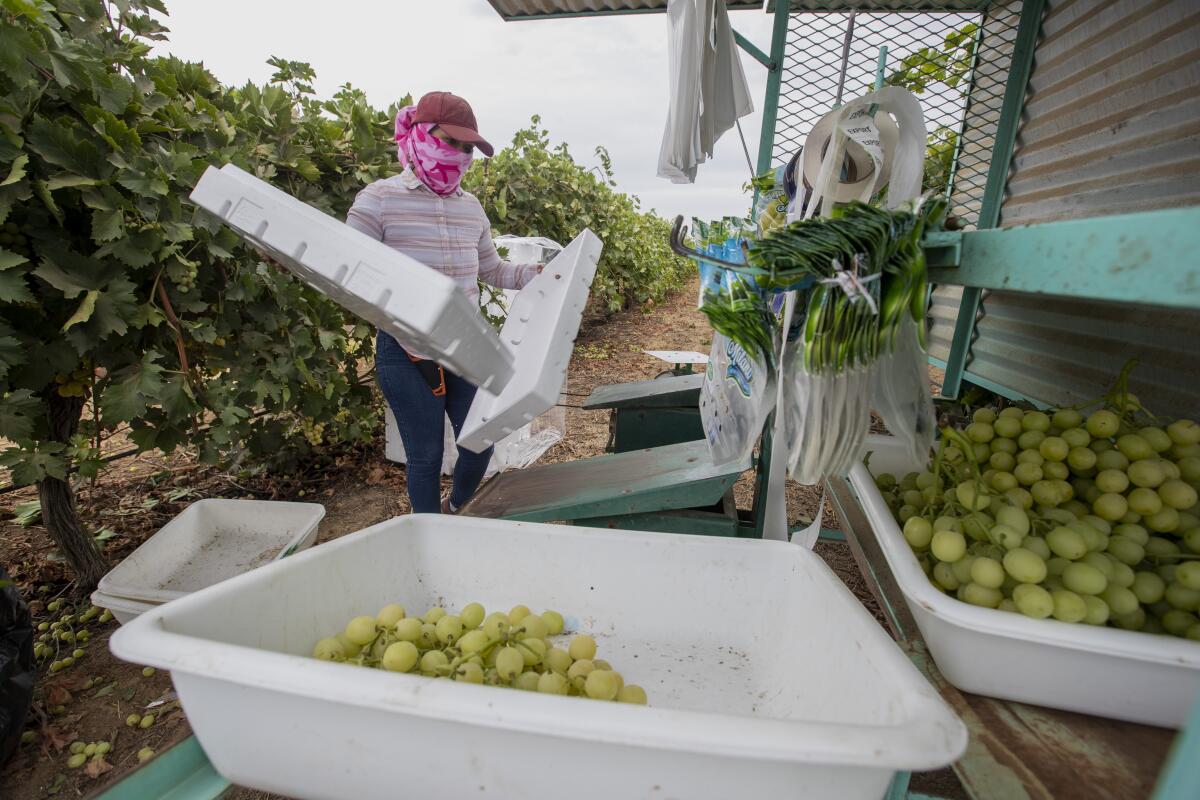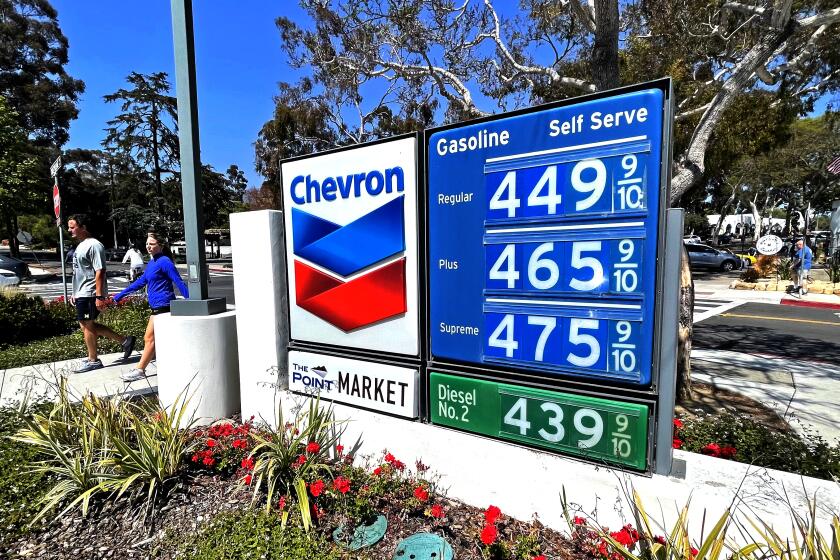California agriculture takes $1.2-billion hit during drought, losing 8,700 farm jobs, researchers find

Severe drought last year caused the California agriculture industry to shrink by an estimated 8,745 jobs and shoulder $1.2 billion in direct costs as water cutbacks forced growers to fallow farmland and pump more groundwater from wells, according to new research.
In a report prepared for the California Department of Food and Agriculture, researchers calculated that reduced water deliveries resulted in 395,000 acres of cropland left dry and unplanted — an area larger than Los Angeles. In estimating the costs, they factored in losses in crop revenue and higher costs for pumping more groundwater.
California’s agriculture industry is the largest in the country, averaging $50 billion in annual revenue and employing more than 400,000 people. The researchers’ analysis shows that the past year of drought had significant economic impacts, and these costs are likely to accumulate as climate change intensifies drought, and as California implements regulations to curb the chronic overpumping of groundwater.
The report, part of a larger three-year study, did not examine how the elimination of some full-time and part-time jobs is playing out for farmworkers. The authors said some workers have turned to taking other jobs, driving longer distances or moving.
“These farmworkers belong to the lowest-income group in the state, particularly in the Central Valley,” said Josué Medellín-Azuara, a water resources economist and associate professor of civil and environmental engineering at UC Merced. “So when climate hits, these communities are hit harder.”
Will gas and food prices continue to rise? How might the conflict in Eastern Europe affect Silicon Valley and Hollywood?
Medellín-Azuara and colleagues from UC Merced, UC Davis and the Public Policy Institute of California estimated changes in the acreage of irrigated farmlands last year as compared to 2018. They surveyed irrigation districts, analyzed water data and reviewed satellite data to track changes in croplands.
In addition to considering the direct effects on farming businesses, the researchers estimated the “spillover effects” in the broader economy and found that analysis pushed the total impacts to more than 14,600 lost jobs, both full-time and part-time, and $1.7 billion in gross revenue losses.
The state is now entering a third year of drought. Many reservoirs remain at low levels and the snowpack in the Sierra Nevada stands at 67% of average for this time of year. Federal water managers announced this week that many farmers should prepare to receive no water from the Central Valley Project.
If the state doesn’t get more precipitation in March, Medellín-Azuara said, “we are likely to see more severe cutbacks from water agencies to agriculture this year, and then the impacts can intensify.”
The past year was one of the driest and hottest on record in California, and comes during a larger 22-year megadrought in the West that research shows is being worsened by global warming.
The researchers found the economic effects on California agriculture last year were comparable to the impacts in 2014, in the middle of the last major drought, which ended in 2016.
But they also found that this time the drought has been more severe in the Sacramento Valley and North Coast regions, leading to an increase in dry farmlands and revenue losses in those areas.
For example, the Russian River Basin has suffered from drier conditions over the past year, Medellín-Azuara said, “so the map of the dry areas changed a little bit.”
His team found that the croplands left fallow included rice fields in the Sacramento Valley, cotton fields in the San Joaquin Valley, as well as farmlands that had been producing grains and other field crops.
These shifts are occurring alongside other long-term changes in crops driven by the global market and other factors. Over the past decade, the acreage planted with wheat, cotton and alfalfa has decreased, while new orchards with high-value pistachios and almonds have expanded across vast stretches of farmland.
The report’s authors cited statistics showing milk remained the state’s top agricultural commodity in 2020, followed by almonds and grapes.
The research shows a substantial economic toll on agriculture, especially in the Central Valley, where the economy depends heavily on farming, said Alvar Escriva-Bou, a coauthor and senior research fellow with the Public Policy Institute of California.
“It’s a lot of money, a lot of jobs,” Escriva-Bou said.
The study focused on revenue losses and pumping costs but didn’t estimate profits in the agriculture industry.
Farming operations in the Central Valley have long turned to pumping more groundwater during droughts, and water levels have been dropping for decades. State lawmakers in 2014 passed the Sustainable Groundwater Management Act, which established a framework for managing groundwater and required local agencies to develop plans to eliminate problems of chronic overpumping.
Local groundwater agencies have been developing plans to begin implementing the law between now and 2040, with state officials overseeing the process and reviewing plans.
In the meantime, declining water levels in farming areas have continued to leave more rural homeowners, including many farmworkers, struggling with dry wells. The state received reports of 975 household wells that ran dry in 2021, many in farming areas in the Central Valley.
The law is expected to gradually bring limits on groundwater pumping that will reduce the strains on depleted aquifers, and these limits will eventually force growers to leave dry a portion of the farmland in the San Joaquin Valley.
Escriva-Bou and other researchers have estimated that at least 500,000 acres of farmland will probably have to stop being irrigated by 2040 to meet groundwater sustainability goals.
He and colleague Ellen Hanak have presented a list of proposals for improving implementation of the groundwater law. Their recommendations include accelerating “demand management,” or limits on pumping, while also planning how to convert some farmlands to other uses, such as solar farms and habitat restoration areas — a direction state officials have supported by budgeting $50 million for a land “repurposing” program.
Steps to reduce groundwater pumping should speed up in areas where water levels are falling, Escriva-Bou said.
“We need to accelerate that to be more resilient. Because if not, we are more vulnerable to droughts like this one,” Escriva-Bou said. At the same time, he said, “we have to think about alternative means of income for farmers and for communities.”
According to state data, agriculture uses nearly 80% of the water that is diverted and pumped for human use in an average year in California.
Medellín-Azuara and other researchers have written that they expect California agriculture will continue to use less water in the long term because of the groundwater law and other factors including expanding development. They’ve also said they expect the state’s agriculture industry will continue to make efficiency improvements and benefit from growing demand for its specialty crops.
“Agriculture in California is very resilient and innovative,” Medellín-Azuara said. “Overall, we are weathering the drought and adapting to future droughts as well.”
Representatives of the agriculture industry said the economic losses, as well as the federal government’s announcement of minimal water deliveries, point to a need for California to build infrastructure projects to capture and store more water, both in groundwater basins and aboveground reservoirs.
The reduction in farming due to water shortages is having broader economic impacts, affecting local governments as well as workers who transport food products, said Danny Merkley, director of water resources for the California Farm Bureau.
“It’s a tremendous hit and it’s going to get worse before it gets better as we see SGMA, the Sustainable Groundwater Management Act, unfold and play out,” Merkley said. He compared groundwater to a savings account, saying the state has cut surface water deliveries — like reducing deposits to a checking account — while also cutting “our ability to go to our fallback, or our savings account.”
Merkley pointed out that California voters in 2014 passed a $7.5-billion water bond measure, Proposition 1, and some of the funds are for infrastructure and water storage projects. He said the toll on the farming economy shows California should move ahead with building these projects to capture more water when wet weather returns.
More to Read
Sign up for Essential California
The most important California stories and recommendations in your inbox every morning.
You may occasionally receive promotional content from the Los Angeles Times.












